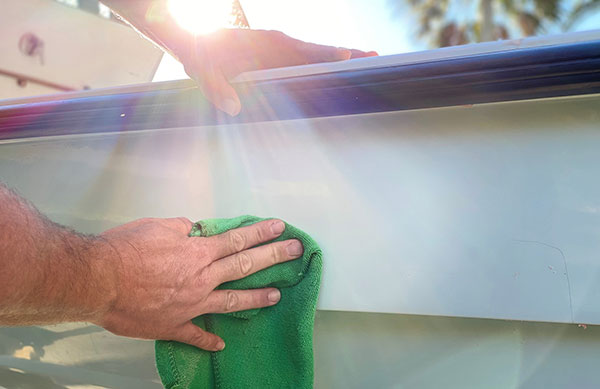- Details
By Louie Stout
Mercury Report
 Boat on the water
Boat on the water
Poor-quality gas and ethanol blends can lead to issues with a boat’s fuel system, yet they’re often the only options available near remote fisheries.
Thankfully, even though fuel quality can’t always be controlled, it can certainly be managed with the Mercury Fuel Care System. The system includes three additive formulas: Quickare®, Quickleen® and Quickstor®.
Quickare Fuel Treatment can be added at every fill-up to help maximize engine performance. Quickleen Engine & Fuel System Cleaner is designed to be used intermittently throughout the season. It helps optimize fuel and remove deposits. Quickstor Fuel Stabilizer is especially important for anglers and boaters who live in the home region of Mercury Pro Team member and 2021 Bassmaster Angler of the Year Seth Feider. A Minnesotan, Feider launched his career up north, where fishing seasons are short and storage seasons are – unfortunately – all too long. He knows that gas left in an idle boat can lead to fuel-related problems down the road if preventive measures aren’t taken.
The fact is, no matter the initial quality, all gas starts to break down after several months. The longer it is left in a boat, the greater the chance of it causing problems, such as hard starting, gumming or varnish formation in the fuel system.
In the video below, Feider shows how easy it is to prevent such troubles by using Mercury Quickstor to stabilize a boat’s fuel system. It only takes 1 ounce to treat 5 gallons of fuel. Once the Quickstor is in the system, it will help prevent the fuel from breaking down and can help keep the fuel system clean for a full year during storage. Using Quickstor is simple and affordable assurance that when the next fishing season kicks off, your engine will be ready to rip.
Keep in mind that stabilizing fuel isn’t limited only to winter prep – and it’s certainly not limited to anglers. It’s a smart move to stabilize fuel in any boat that might sit for more than a couple of weeks, like a boat stored at a summer cabin or a family boat that is used only on occasion due to other obligations competing for your time. Quickstor has you covered. It works with any brand and type of gasoline-powered marine engine, whether carbureted or fuel injected. It can even be used in lawnmowers, ATVs and other small engines before storage.
So when you are ready to winterize, watch the included video for Feider’s advice. Then follow these steps to get the job done right.
How to Stabilize Fuel with Quickstor:
- If you have old gas in your boat, run your tank as close to empty as you can get it or pump the fuel into your tow vehicle. If you have new gas in your tank, you can skip this step.
- Add Quickstor to the fuel tank. It’s ideal to add it before you refill the tank so the new gas will thoroughly mix with the stabilizer. Add 1 ounce for every 5 gallons of gas that your fuel tank holds. If you put a little too much in, that’s OK.
- If you can find ethanol-free gas in your area, use it to refill your boat’s tank. That alone can prevent a lot of problems. Otherwise, buy gas from a trusted source that you know is getting new fuel on a regular basis. For most modern boats, fill the tank to the very top to prevent condensation from forming in the tank. In an older boat with a vented fuel tank, it’s recommended to only fill the tank about 95% full. Otherwise, extreme low temperatures can cause the fuel in a full tank to expand and spill out the vents.
- Back the boat into the water or connect it to a garden hose and engine muffs to maintain a flow of cooling water. Then start the engine and let it idle for 5 to 10 minutes to distribute the stabilizer throughout the fuel system.
Winterization Matters
Quickstor should be a part of the winterization process for any marine engine. Also be sure to replace the fuel filter and, if servicing a four-stroke engine, to change the oil and oil filter. Then follow any other winterization procedures recommended in your engine owner’s manual before putting the boat up for the season. If you’re not interested in DIY, a Mercury Authorized Dealer can always help you out, too.
Proper fuel care during boating season and ahead of storage will make sure your engine will be ready to go next spring, whether you plan to chase fishing’s biggest titles, like Feider, or you simply want to enjoy fun and adventure on your local waters.
- Details
Mercury Report
 Waxing a boat
Waxing a boat
Other than actually being on the water, nothing brings a smile to a boater’s face faster than that moment when they step back and admire a gleaming, freshly waxed boat, shining like the day it came home.
A proper waxing not only keeps a boat looking sharp, but it’s also part of the routine cleaning process that helps prevent dirt and grime from permanently abrading or staining visible surfaces.
Most boaters only wax their entire boat at the beginning and/or end of the season. However, some heavy users elect to do an additional interior or above-waterline wax every month or two.
How often you wax your boat is up to you, but make sure you’re using a paste or liquid wax that is specially formulated for boats. Automotive wax isn’t intended for the marine environment.
There is a deep divide in the boating community about whether to wax the bottom of a boat. Some claim that waxing the bottom causes the boat to “stick” tighter to the water while underway, causing a slight loss of speed or efficiency. Others champion the notion that a waxed hull is much less apt to be stained by murky water and mud, and that the long-term aesthetic improvement and protective barrier outweigh any minute speed loss. The choice is yours, but for most people the added protection is worth it.
The wax you buy will include specific application instructions, but the following basic procedure is standard:
- Thoroughly wash and dry the boat before waxing. This is critical. Waxing involves a lot of rubbing, so any dirt or debris will have a “sandpaper effect” on the finish.
- Use an application pad or extra-soft rag to rub on the wax using small, circular motions. Apply it to one section at a time, focusing on no more than a few square feet in area, before moving to the next part. Follow the manufacturer’s recommendations throughout this process since leaving the wax in place too long can make it difficult to finish the buffing process in the next step. You might need to buff each small area before applying wax to the next part. For best results, cover no more than one side of the boat at a time.
- Now buff the wax. Buffing entails rubbing down all waxed areas with an extra-soft towel or a chamois. Use a circular motion to remove all traces of the excess wax. Keep polishing until you get as close as possible to a mirror finish.
- Repeat the process until you’ve covered every surface. Some brands of wax should be applied using multiple passes, while others specify one pass only.
That’s it. For a quick boost in between full applications, you might consider carrying a spray bottle of quick-application spray wax in your boat. Just spritz a little on the most vulnerable surfaces and then wipe it down to maintain the shine. Regardless of how often you wax your boat, all it really takes is a little effort to achieve a finish you can be proud of
Pro Tip: Try a Power Buffer
Applying and buffing out wax can be done entirely by hand as described, but it will go a lot quicker – and be much easier – with a power buffer. You could try renting one first to see how you like it. A power buffer requires special application and buffing pads, which are available at marine stores and dealerships that sell boat wax. Follow the instructions to make sure you don’t damage the boat’s finish.




